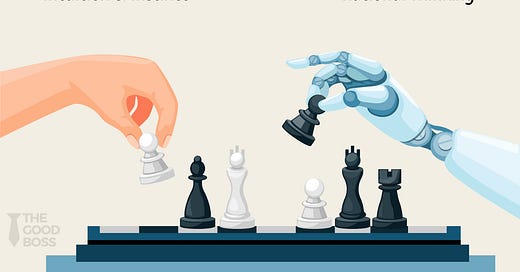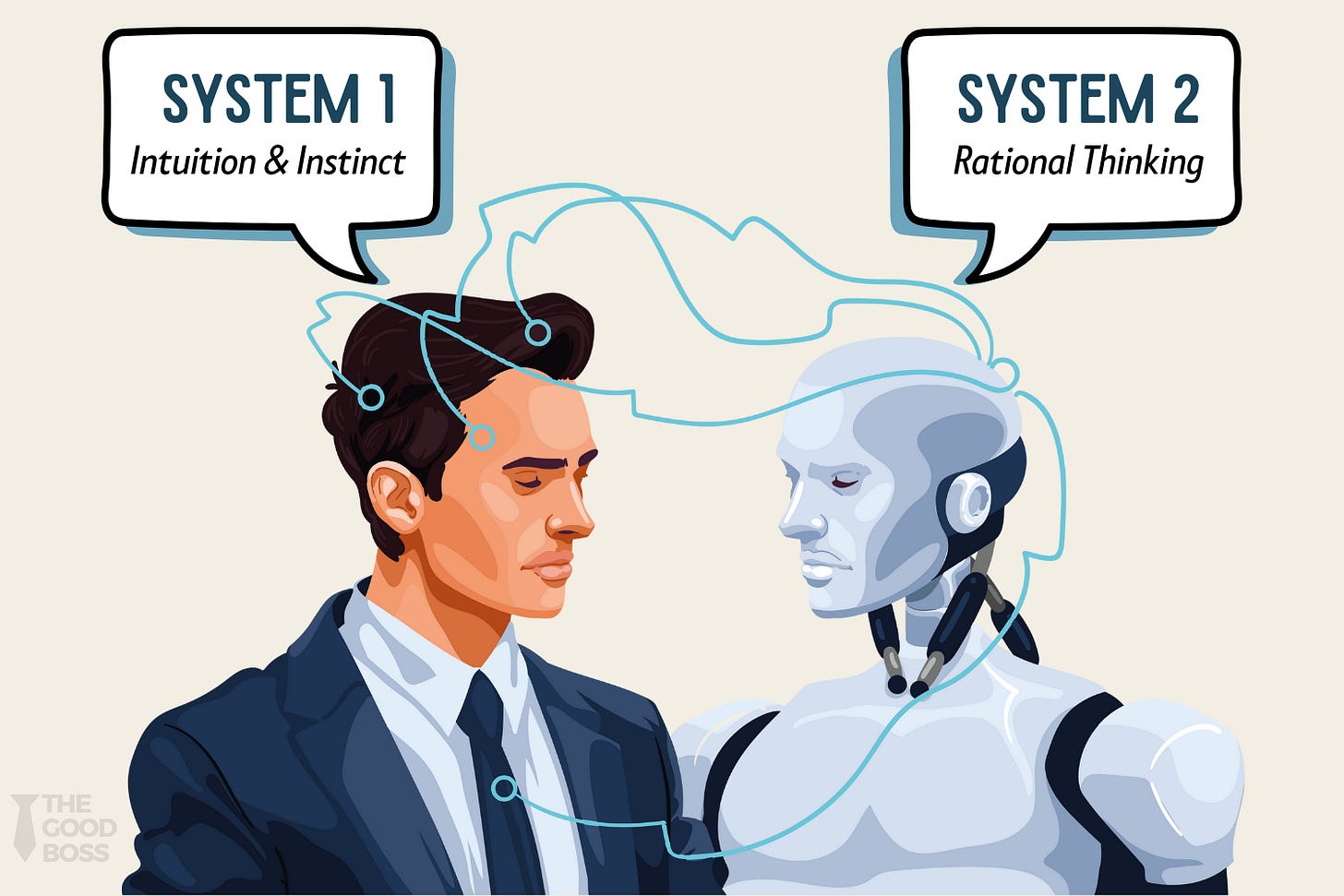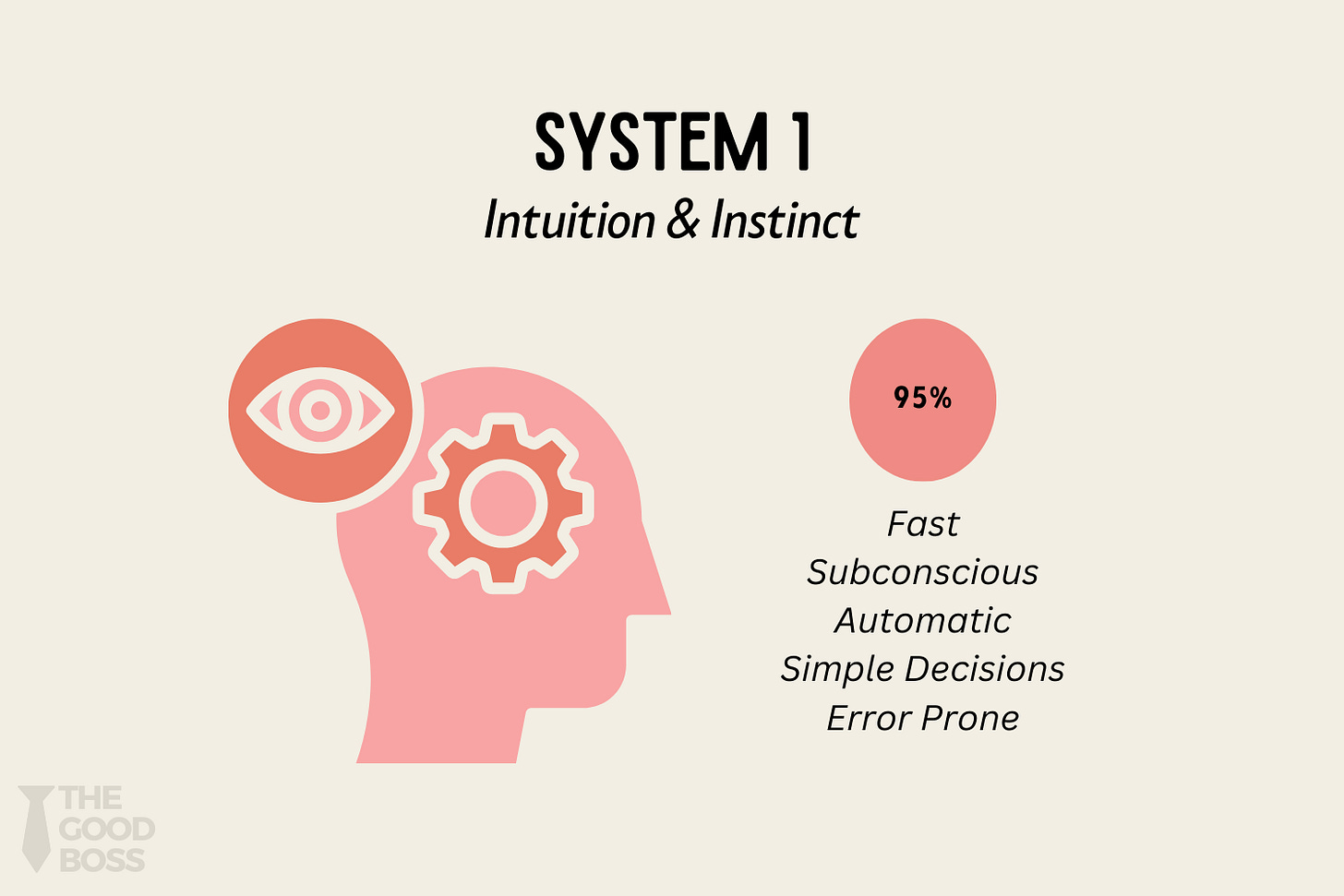System 1 and 2 Thinking: When to Trust Your Gut and When to Think Twice as a Leader
A Science-Backed Model for Better, Bias-Free Decision-Making
In this issue:
Fight or Flight?
Understanding System 1 and System 2 Thinking
When to Use System 1 Thinking in Leadership
When to Use System 2 Thinking in Leadership
Balancing System 1 and System 2 Thinking
Applying System 1 and 2 Thinking in Leadership
Examples of Effective Use of System 1 and System 2 in Leadership
Common Mistakes to Avoid
The System 1 and 2 Thinking Application Worksheet
Complementary Frameworks
Further Reading
Final Thoughts
✨
Fight or Flight?
Imagine you’re driving on your regular commute to work, and the car in front of you abruptly slams its brakes.
What do you do?
Most people instinctively press the brakes.
That’s System 1 thinking in action—your automatic, intuitive, fast response that kicks in without conscious effort. Sometimes referred to as the fight or flight response, it’s the survival mechanism that has kept humans alive for millions of years.
Now imagine a different scenario. You’re a leader in a boardroom, faced with a critical business decision—whether to expand into a new market, launch a new product, or restructure your team. You carefully analyze the data, weigh the risks, consider multiple perspectives, and debate possible outcomes before making a move.
That’s System 2 thinking—slow, deliberate, and analytical.
Both of these thinking modes, identified by Nobel Laureate Daniel Kahneman in his book Thinking, Fast and Slow, influence every decision you make, whether in daily life or in leadership.
As a leader, knowing when to use each mode of thinking is crucial for making better decisions. Let’s explore how you can leverage both System 1 and System 2 to navigate leadership challenges with clarity and confidence.
Understanding System 1 and System 2 Thinking
System 1 and System 2 thinking describe two distinct ways the brain processes information:
System 1 (Fast Thinking)
Operates automatically and effortlessly.
Uses intuition, emotions, and pattern recognition.
Drives snap judgments and gut reactions.
Can be prone to biases and errors.
System 2 (Slow Thinking)
Requires focus and mental effort.
Uses logic, analysis, and structured problem-solving.
Helps with complex decision-making.
More accurate but also more time-consuming.
Think of System 1 as your survival instinct, enabling you to react quickly to immediate threats and opportunities. It’s your first line of defense in crises.
Meanwhile, System 2 is your rational thinker, helping you weigh long-term consequences and navigate complex leadership decisions.
Great leaders don’t just default to one system over the other. They understand when to switch gears.
When to Use System 1 Thinking in Leadership
System 1 thinking is essential when quick, decisive action is needed. Here are a few leadership scenarios where it plays a key role:
Crisis Management
When an urgent issue arises, leaders must respond swiftly. Suppose your company experiences a cybersecurity breach. In the first few minutes, you don’t have the luxury of deep analysis—you need immediate damage control. Your instincts guide you toward notifying stakeholders, securing systems, and activating your incident response team.
People and Team Dynamics
Leadership is as much about emotional intelligence as it is about strategy. System 1 helps you read subtle cues—body language, tone, and energy levels. It allows you to detect morale issues, spot tensions, and react with empathy.
Rapid Business Decisions
In fast-moving industries, waiting too long can cost opportunities. If a competitor launches a disruptive product, you might need to pivot quickly based on your gut feel and market experience rather than conducting months of research.
While System 1 is fast, it can be prone to biases—overconfidence, confirmation bias, and emotional decision-making.
You should use System 1 for immediate responses but follow up with System 2 for a thorough evaluation.
When to Use System 2 Thinking in Leadership
System 2 is crucial for decisions that require deep thought, strategy, and foresight.
Strategic Planning
When making long-term business decisions—such as expanding into new markets—you need a data-driven approach. You’ll analyze customer demand, competitive landscapes, financial viability, and regulatory implications.
Example: Expanding to a new country feels right (System 1), but a detailed market analysis might reveal logistical challenges, cultural differences, or legal barriers (System 2).
Complex Problem-Solving
Imagine a high-profile client threatens to cancel a multi-million-dollar contract due to dissatisfaction. A quick System 1 reaction might be to offer a discount or apologize. But System 2 thinking encourages a root cause analysis—what led to the issue? How can it be prevented in the future?
Performance Reviews and Promotions
A leader might instinctively want to promote an employee who closed a massive deal. But a deep dive into performance data might reveal that another team member contributed significantly behind the scenes. System 2 ensures fair, data-backed decisions.
Balancing System 1 and System 2 Thinking
Effective leaders don’t choose between System 1 and System 2. They balance both.
Here’s how you can integrate them:
Recognize Your Biases
System 1 thinking is full of biases. Leaders must ask themselves:
Am I making this decision too quickly without enough data?
Am I favoring a familiar idea just because it feels right?
Have I consulted multiple perspectives?
Try This: Before making a major decision, pause and challenge your first instinct. Does it hold up to scrutiny?
Use Decision-Making Frameworks
Frameworks help structure thinking. Here are a few you can leverage:
OODA Loop: Observe → Orient → Decide → Act (great for fast decisions)
First Principles Thinking: Break complex problems into fundamentals. Check out First Principles Thinking: How Elon Musk Built SpaceX for a deep-dive.
The 5 Whys: Identify the root cause of issues. Check out The 5 Whys Framework: How To Move From Symptoms to Root Causes for a deep-dive.
Combine Brainstorming with Structured Analysis
Encourage free-flowing ideas (System 1) in early brainstorming, then analyze them critically (System 2) before making decisions.
Try This: In meetings, allow team members to share initial gut reactions before diving into data-backed discussions.
Conduct Retrospectives
Reflection helps refine decision-making. After a major project, ask:
What worked?
Where did intuition help?
Where should we have used more analysis?
Try This: Hold monthly “Decision Reviews” with your team to analyze past choices and refine future decision-making processes.
Applying System 1 and 2 Thinking in Leadership
Now, let’s turn our attention to making this framework work for you in your role as a leader. Doing this methodically will help you to improve the quality of the decisions you make.
Next, we will:
Review several examples of the effective use of System 1 and 2 Thinking in real-world leadership scenarios
Review common mistakes you should avoid while using this model
Make it real: Put the power of this model into practice with the System 1 and 2 Thinking worksheet, which includes step-by-step prompts to guide you through the application process. (Note: Paid members enjoy FREE access to the entire collection of worksheets!)
Review some complementary frameworks that work well with this model
Review additional resources to further your understanding
Close out with some key takeaways







